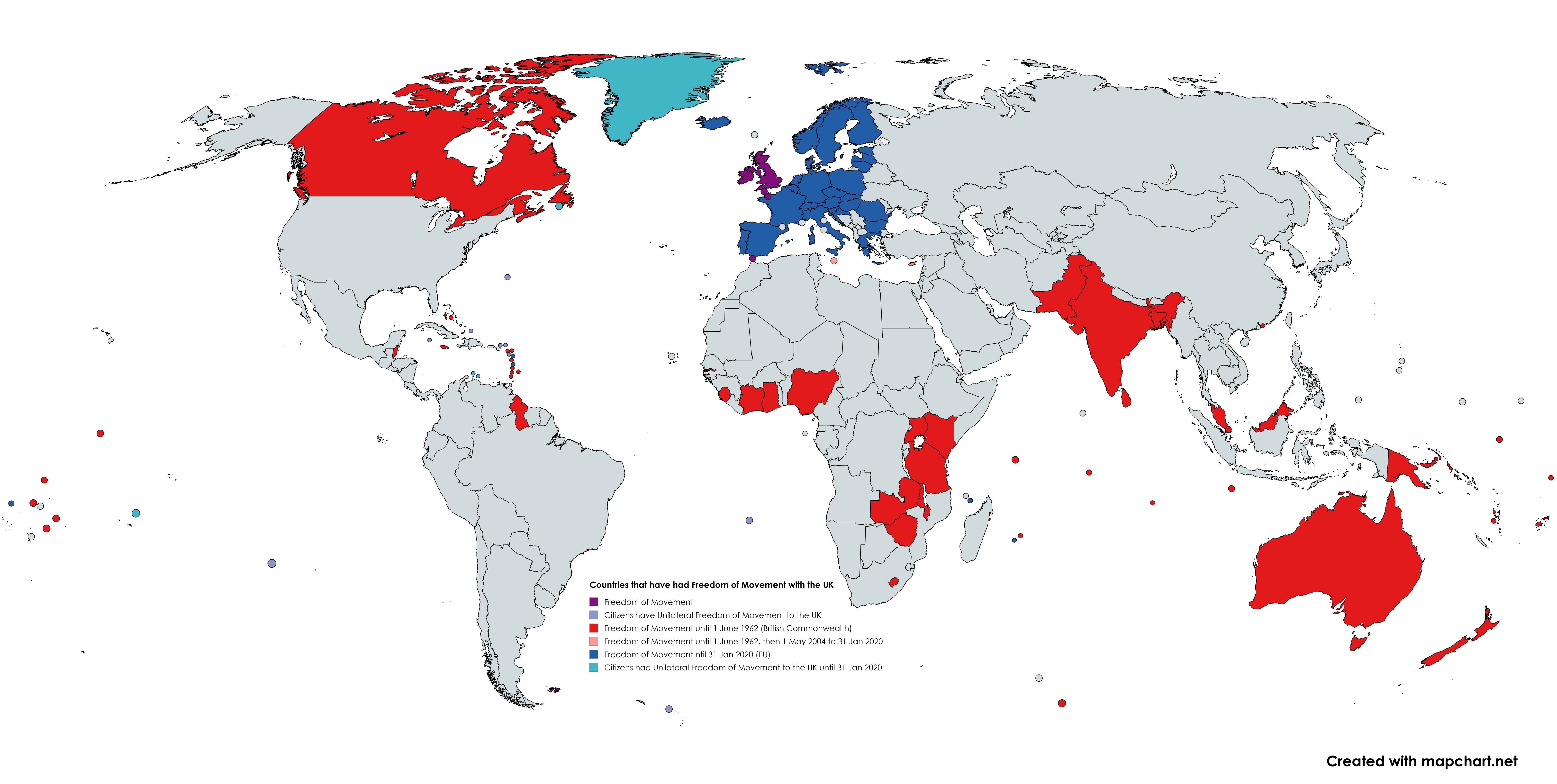UK Historical Freedom of Movement Regimes Map


Marcus Rodriguez
Historical Geography Expert
Marcus Rodriguez specializes in historical cartography and geographic data analysis. With a background in both history and geography, he brings unique...
Geographic Analysis
What This Map Shows
This map illustrates the historical regimes of freedom of movement between the UK and various nations, specifically highlighting the relationships that existed prior to the UK's imposition of restrictions in 1962. It captures a significant shift in international relations, marking the end of an era where numerous nations enjoyed unrestricted access to the UK. The map acts as a visual representation of the countries that were once part of the British Commonwealth or had established relations that allowed free movement, showcasing how colonial history has shaped modern migration patterns.
Deep Dive into Freedom of Movement
Freedom of movement has been a pivotal aspect of migration and international relations throughout history, especially during the 20th century. After World War II, the British Empire began to dismantle itself, leading to the independence of many colonies. Consequently, the Commonwealth transitioned from a colonial power structure to a voluntary association of sovereign states. However, the privilege of free movement into the UK was primarily reserved for Dominions, Crown Colonies, and fully independent nations that were members of the Commonwealth.
Historically, nations such as Canada, Australia, New Zealand, and South Africa were granted freedom of movement, allowing their citizens to live, work, and settle in the UK without restrictions. This privilege was based on bilateral agreements and shared histories, reflecting the close ties forged during the colonial period. Interestingly, South Africa's departure from the Commonwealth in 1961 marked a significant turning point, as it lost this privilege just a year before the UK started implementing restrictions.
What’s fascinating is that not all territories under British control received the same treatment. For instance, protectorates like Brunei, Botswana, and the Gulf States did not qualify for freedom of movement since this privilege was conditional on their status as Dominions or fully independent Commonwealth nations. Consequently, the map sheds light on the nuanced and often complex relationships between the UK and its former colonies.
Furthermore, Cyprus and Malta uniquely lost their freedom of movement twice. Initially, both were granted this privilege as British Crown Colonies until 1962, regained it upon joining the EU in 2004, and subsequently lost it again with Brexit in 2020. This cyclical pattern of movement rights highlights how geopolitical changes can have lasting impacts on citizens' mobility and rights.
Regional Analysis
Examining the map regionally reveals notable distinctions in freedom of movement statuses. For example, the Dominions of Canada and Australia maintained strong ties with the UK, facilitating robust migration flows. These nations not only benefitted from historical connections but also shared cultural and linguistic similarities, which eased the integration of their citizens into British society.
Conversely, countries like Ghana and Nigeria, which gained independence in the mid-20th century, initially enjoyed freedom of movement. However, as the UK began to tighten its immigration policies in the early 1960s, these rights were curtailed, affecting the migration aspirations of many West Africans. The restrictions had profound implications for communities and families, often leading to a sense of disconnection from the UK, a country many viewed as their colonial motherland.
Interestingly, the Caribbean nations that were part of the Commonwealth, such as Jamaica and Trinidad and Tobago, also faced similar challenges. The economic landscape shifted dramatically post-1962, changing the dynamics of migration and the perception of opportunities in the UK. The map serves as a reminder of the diverse and often tumultuous histories that shaped these relationships.
Significance and Impact
Understanding the historical regimes of freedom of movement in the UK is crucial for grasping current migration trends and policies. As the world becomes more interconnected, countries are grappling with the legacy of colonialism and its implications for contemporary migration. The restrictions imposed in 1962 represented not just a change in policy but also a reconfiguration of identity and belonging for many nations formerly associated with the UK.
Today, migration continues to be a hot-button issue, particularly in the context of Brexit, where new policies are being implemented that will redefine the movement of people between the UK and the EU. The historical context provided by this map allows us to critically analyze how past relationships influence current decisions, offering insights into the complexities of national identity, economic opportunities, and social integration. As we move forward, understanding these historical frameworks will be essential for navigating the ever-evolving landscape of global migration.
Visualization Details
- Published
- September 19, 2025
- Views
- 62
Comments
Loading comments...